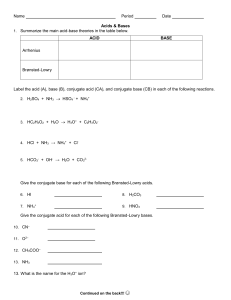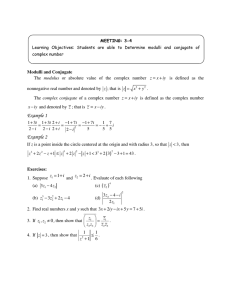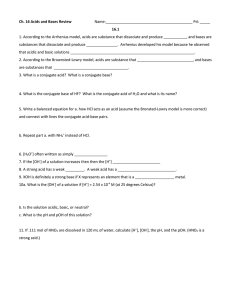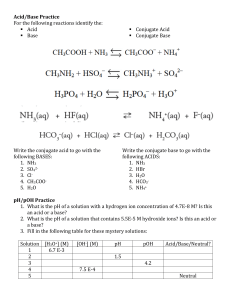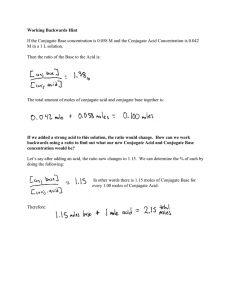Acid/Base Equilibria Quiz KEY - Chemistry Problems & Solutions
advertisement
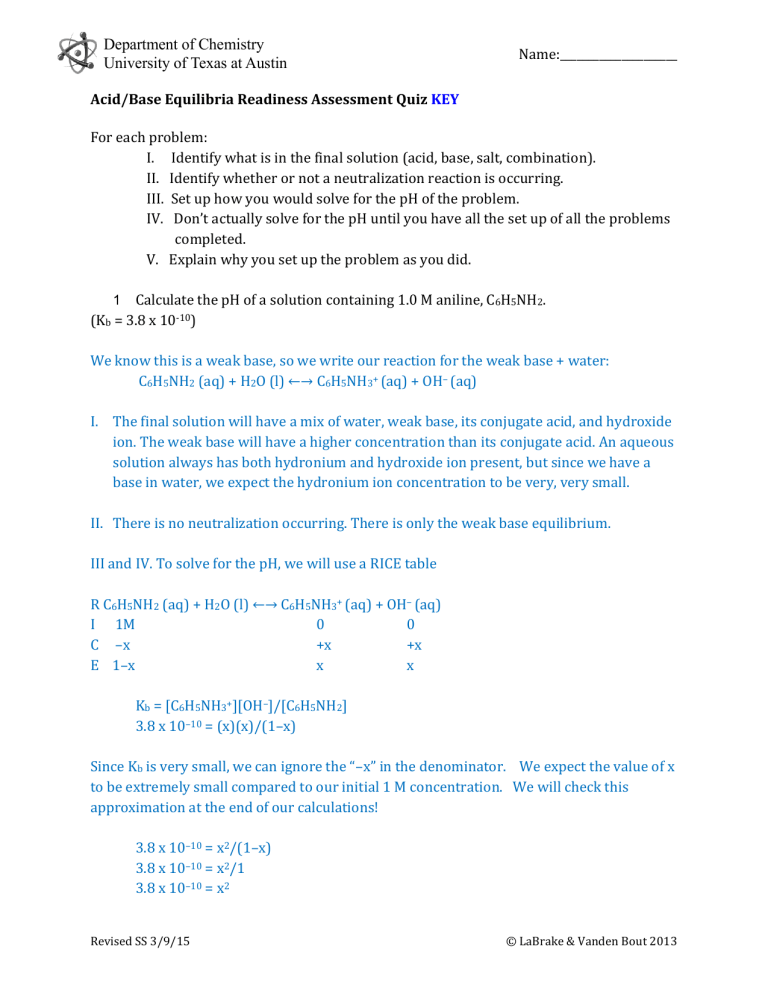
Department of Chemistry University of Texas at Austin Name:_____________________ Acid/Base Equilibria Readiness Assessment Quiz KEY For each problem: I. Identify what is in the final solution (acid, base, salt, combination). II. Identify whether or not a neutralization reaction is occurring. III. Set up how you would solve for the pH of the problem. IV. Don’t actually solve for the pH until you have all the set up of all the problems completed. V. Explain why you set up the problem as you did. Calculate the pH of a solution containing 1.0 M aniline, C6H5NH2. (Kb = 3.8 x 10-10) 1 We know this is a weak base, so we write our reaction for the weak base + water: C6H5NH2 (aq) + H2O (l) ←→ C6H5NH3+ (aq) + OH– (aq) I. The final solution will have a mix of water, weak base, its conjugate acid, and hydroxide ion. The weak base will have a higher concentration than its conjugate acid. An aqueous solution always has both hydronium and hydroxide ion present, but since we have a base in water, we expect the hydronium ion concentration to be very, very small. II. There is no neutralization occurring. There is only the weak base equilibrium. III and IV. To solve for the pH, we will use a RICE table R C6H5NH2 (aq) + H2O (l) ←→ C6H5NH3+ (aq) + OH– (aq) I 1M 0 0 C –x +x +x E 1–x x x Kb = [C6H5NH3+][OH–]/[C6H5NH2] 3.8 x 10–10 = (x)(x)/(1–x) Since Kb is very small, we can ignore the “–x” in the denominator. We expect the value of x to be extremely small compared to our initial 1 M concentration. We will check this approximation at the end of our calculations! 3.8 x 10–10 = x2/(1–x) 3.8 x 10–10 = x2/1 3.8 x 10–10 = x2 Revised SS 3/9/15 © LaBrake & Vanden Bout 2013 Department of Chemistry University of Texas at Austin Name:_____________________ x = 1.95 x 10–5 x = [OH–] = 1.95 x 10–5 M Was it OK to ignore the “x” in “1-x”? Yes! The value of x is significantly smaller (at least 100 times less) than the initial concentration of the weak base, Kb is less than 1 x 10–4 and our initial concentration of weak base is greater than 0.05M. So by all accounts, the assumption to ignore the “–x” is safe. We can then find the pOH: pOH = –log(1.95 x 10–5) = 4.71 pH = 14 – pOH pH = 14 - 4.71 pH = 9.29 V. We set up this problem with only one RICE table because it is a weak base equilibrium problem. Once we used RICE to find the OH–concentration, we knew that the negative logarithm of this value would give pOH. At room temperature, the sum of pOH and pH is 14, so to find pH we simply subtract pOH from 14. 2. Calculate the pH of a solution containing 0.25 M anilinium chloride, C6H5NH3Cl. First, think about what you know about this molecule. What is C6H5NH3Cl? This compound is a salt. What kind of salt is it? Let’s look at how it will break down in water: C6H5NH3Cl (aq) → C6H5NH3+ (aq) + Cl– (aq) We know Cl– has a negative charge, thus the other part of the molecule must have a positive charge since the original salt has a neutral (zero) charge. Cl– would be the conjugate base of HCl, but we know HCl is a strong acid, and dissociates completely. Therefore, Cl– does NOT spontaneously pick up an H+ to form HCl in solution. Essentially, Cl– would be so exceedingly weak as a base that we do not consider it a base at all. Cl– will be a spectator ion. C6H5NH3+ now looks like a derivative of the ammonium ion! This is a weak acid. Revised SS 3/9/15 © LaBrake & Vanden Bout 2013 Department of Chemistry University of Texas at Austin Name:_____________________ How does the weak acid interact with water? C6H5NH3+(aq) + H2O (l) ←→ C6H5NH2 (aq)+ H3O+ (aq) I. The final solution will have a mix of water, the weak acid, its conjugate base, and hydronium ion. An aqueous solution always has both hydronium and hydroxide ion present, but since we have an acid in water, we expect the hydroxide ion concentration to be very, very small. II. There is no neutralization occurring, there is only a weak acid equilibrium. III. We can solve this using a RICE table. Since this is a weak acid problem, we will need the Ka of C6H5NH3+. We know the Kb from problem #1 and we know that Kw = Ka x Kb Ka = Kw/Kb Ka = 1 x 10–4 ÷ 3.8 x 10–10 = 2.63 x 10–5 R C6H5NH3+(aq) + H2O (l) ←→ C6H5NH2 (aq)+ H3O+ (aq) I 0.25M 0 0 C -x +x +x E 0.25-x x x Ka = [C6H5NH2][H3O+]/[C6H5NH3+] 2.63 x 10–5 = (x)(x)/(0.25–x) Since Ka is small, we can ignore the “–x” in the denominator. We expect the value of x to be small compared to our initial 0.25 M concentration. We will check this approximation at the end of our calculations! 2.63 x 10–5 = x2/0.25 (2.63 x 10–5)•0.25 = x2 x = 2.56 x 10–3 Was it OK to ignore the “x” in “0.25–x”? Yes! The value of x is significantly smaller (100 times less) than the initial concentration of the weak acid, 0.25 M (although, notice here that we were getting close to the value, so this is a borderline case). Ka is less than 1 x 10–4 and our initial concentration of weak acid is greater than 0.05M. So by all accounts the assumption to ignore the “–x” is safe. Revised SS 3/9/15 © LaBrake & Vanden Bout 2013 Department of Chemistry University of Texas at Austin Name:_____________________ IV. What does x mean? We look back at our RICE table x = [H3O+] = 2.56 x 10–3 pH = –log[H3O+] = –log(2.56 x 10–3) pH = 2.59 V. We set up this problem with only one RICE table because it is a weak acid equilibrium problem. Once we used RICE to find the H3O+ concentration, we knew that the negative logarithm of this value would give pH. 3. Calculate the pH of a solution containing 0.10 M aniline, C6H5NH2, and 0.25 M anilinium chloride, C6H5NH3Cl. From the previous problems, we have identified C6H5NH2 to be a weak base and have seen that when in water the salt anilinium chloride dissociates completely into C6H5NH3+ and Cl–. C6H5NH3Cl (aq) → C6H5NH3+(aq) + Cl–(aq) I. This solution contains significant concentrations of a weak base with its conjugate acid. We have a buffer solution! We know there will also be water, hydronium, and hydroxide ion. The ratio of hydronium to hydroxide ion will be dependent on the relative strengths of the conjugate acid and base. Write a reaction with water that shows both the acid and its conjugate base: C6H5NH2(aq) + H2O (l) ←→ C6H5NH3+(aq) + OH–(aq) Kb = 3.8 x 10–10 (from problem #1) OR C6H5NH3+(aq) + H2O (l) ←→ C6H5NH2(aq) + H3O+ (aq) Ka = 2.63 x 10–5 (calculated in problem #2) II. There is no neutralization occurring. Equilibrium between weak base and its conjugate acid is taking place in solution. III. Based on what we have in solution, we have a BUFFER. We can use the HendersonHasselbalch equation or solve using our Ka or Kb expressions. IV. pOH = pKb + log([BH+]/[B]) OR pH = pKa + log([A-]/[HA]) Revised SS 3/9/15 © LaBrake & Vanden Bout 2013 Department of Chemistry University of Texas at Austin Name:_____________________ You could choose either of our reactions showing both the acid and conjugate base. We will pick the top reaction, showing the base reacting with water to form the acid and hydroxide. C6H5NH2(aq) + H2O (l) ←→ C6H5NH3+(aq) + OH–(aq) Kb = 3.8 x 10-10 (from problem #1) Since this is the reaction of the base with water, we will use the associated HH equation: pOH = pKb + log([BH+]/[B]) pKb = –log(Kb) = –log(3.8 x 10–10) = 9.42 [BH+] is the conjugate acid or the protonated form of the base: C6H5NH3+ [B] is the unprotonated weak base: C6H5NH2 pOH = 9.42 + log(0.25M/0.10M) = 9.82 pH = 14 – pOH = 14 – 9.82 = 4.18 If using the other equation: pH = pKa + log([A–]/[HA]) pH = 4.58 + log(0.1M/0.25M) pH = 4.58 + (–0.398) = 4.18 BOTH versions of the equation get the same final pH! V. We recognized that we had both a weak species and its conjugate pair in solution together. There was no strong acid or strong base for the weak species to react with, so we knew that we only had to set up an aqueous equilibrium between the conjugate acid/base pair and use Henderson Hasselbach to find pH. 4. Calculate the pH of a solution containing the result of the addition of 0.5 moles HCl to a solution of 1 liter from problem 1. I. We have a strong acid, HCl, being added to a weak base aniline C6H5NH2 (Kb = 3.8 x 10–q0). When combined, the strong acid donates its proton to the weak base until one of the two species is exhausted! This is a completion reaction so we would write the equation: C6H5NH2 (aq) + HCl (aq) → C6H5NH3Cl(aq) + H2O (l) Revised SS 3/9/15 © LaBrake & Vanden Bout 2013 Department of Chemistry University of Texas at Austin Name:_____________________ In one liter of 1.0M of aniline, there are 1.0 moles of the base (1.0 mol/L • 1L = 1.0 moles). We are adding 0.5 moles of HCl. The weak base and HCl react in a 1:1 ratio, so we will be left with excess base reactant and no remaining HCl! With leftover weak base reactant and with the conjugate acid salt that was created, we will have a BUFFER solution (provided that the two species have concentrations of roughly the same magnitude - we will find out). II. A neutralization reaction is occurring: the strong acid reacts with the weak base to form water and a salt. III. We will use a RICE table to solve the neutralization reaction. Then, we will have a mixture of weak base and its conjugate acid so we can use Henderson Hasselbalch. RICE tables that go to completion are best done in moles! R I C E C6H5NH2 (aq) + HCl (aq) → C6H5NH3Cl(aq) + H2O (l) 1 mol 0.5 mol 0 mol ---–0.5 mol –0.5 mol +0.5 mol ---0.5 mol 0 mol 0.5 mol ---- Now we have equal amounts of C6H5NH2 and C6H5NH3Cl. This is a solution containing a weak base and its conjugate acid! In one liter, they have equal concentrations of 0.5M each. We can use Henderson Hasselbalch. IV. pOH = pKb + log([HB+]/[B]) pKb = –log(Kb) = –log(3.8 x 10–10) = 9.42 [HB+] is the conjugate acid or the protonated form of the base: C6H5NH3+ [B] is the unprotonated weak base: C6H5NH2 pOH = 9.42 + log(0.5M/0.5M) = 9.42 + 0 pH = 14 – pOH = 14 – 9.42 = 4.58 V. We knew that the strong acid would react completely with any base first. When we ran this neutralization reaction, there was excess weak base in solution with its conjugate acid. They had concentrations of equivalent magnitude so we could use Henderson Hasselbalch to evaluate the pH. We selected the pOH version of Henderson Hasselbalch because it’s easier to think of aniline species in terms of bases. At room temperature, the sum of pOH and pH is 14, so to find pH we simply subtracted pOH from 14. Revised SS 3/9/15 © LaBrake & Vanden Bout 2013 Department of Chemistry University of Texas at Austin Name:_____________________ 5. Calculate the pH of a solution containing the result of the addition of .01 moles of HCl to 1 liter of the solution from problem 3. In problem 3 we found we had a buffer with 0.10 M of the base, C6H5NH2 and 0.25 M of its conjugate acid C6H5NH3+ I. We expect the strong acid to react with the weak base in our buffer solution. The HCl will react with the base in the buffer to form more of the buffer conjugate acid. We expect to still have a buffer solution assuming the strong acid does not exhaust the base (and it won’t as we have fewer moles of HCl than we have moles of the weak base), but the ratio of buffer acid:base will increase slightly, changing the pH of the buffer solution slightly. II. A neutralization reaction is happening since we have a strong acid and a weak base in solution reacting to form water and a salt. III. We can think of this type of problem as two steps: Step 1: A stoichiometry part, where you are calculating the change in concentrations of the buffer components – the weak acid and its conjugate base (or the weak base and its conjugate acid). Here we will use our RICE table in moles. Step 2: An equilibrium part, where you use these new concentrations of the buffer components to find the new [H3O+]. You can do this with the Ka expression, rearranging to [H3O+] = Ka[HA]/[A-] or with the Henderson-Hasselbalch equation. Step I: Since we have 1 L of our solution from #3, we will have 0.1 moles of C6H5NH2 (0.1 M x 1 L = 0.1 moles) and 0.25 moles of C6H5NH3+ (0.25 M x 1 L = 0.25 moles) We are working our RICE table in moles. You could also work it in concentration units since we’re actually not changing volumes in this particular problem. However, we almost always do neutralization in moles, so we’ll stick with our pattern. Since we are working in moles, we will need to remember to convert to M before doing any equilibrium Ka or Henderson-Hasselbalch equation. R C6H5NH2 (aq) + HCl (aq) → C6H5NH3Cl(aq) + H2O (l) I 0.1mol 0.01mol 0.25mol C –0.01mol –0.01mol +0.01mol END 0.09mol 0mol 0.26mol Revised SS 3/9/15 © LaBrake & Vanden Bout 2013 Department of Chemistry University of Texas at Austin Name:_____________________ Step 2: From here, we can use our Henderson-Hasselbalch equation. We were told a number of moles of HCl have been added and since no volume or molarity of this added acid is given, we will assume that the volume of the solution did not change. Therefore, our final concentrations are just the number of moles divided by 1L: [C6H5NH2] = 0.09M [C6H5NH3+] = 0.26M pOH = pKb + log([HB+]/[B]) pKb = –log(Kb) = –log(3.8 x 10–10) = 9.42 [HB+] is the conjugate acid or the protonated form of the base: C6H5NH3+ [B] is the unprotonated weak base: C6H5NH2 pOH = 9.42 + log(0.26M/0.09M) pOH = 9.42 + 0.46 = 9.88 pH = 14 – pOH = 14 – 9.88 = 4.12 Does this answer make sense? Yes! We are increasing our buffer acid:base ratio. More acid should mean a lower pH and we see our pH is now slightly lower than that in problem #3. V. We knew that the strong acid would react completely with any base first. When we ran this reaction, there was excess weak acid in solution with its conjugate base. We calculated the new concentrations of the buffer acid and base after the neutralization reaction was run and then used the Henderson-Hasselbalch equation to evaluate the pH. 6. Sketch a titration curve of a strong acid and a strong base. Then sketch and fully label the titration curve of a strong base and a weak acid. Strong acid titrated with strong base (NaOH in this example): Revised SS 3/9/15 © LaBrake & Vanden Bout 2013 Department of Chemistry University of Texas at Austin Name:_____________________ We know that we begin with an acid analyste because the intial pH is low (less than 7). The titrant must be a base because ethe pH increases with the addition of the titrant. Finally we know that the analyte must be a strong acid and the titrant must be a strong base because the pH is neutral at the equivalence point (pH = 7 at equivalence point). Weak acid titrated with a strong base: Revised SS 3/9/15 © LaBrake & Vanden Bout 2013 Department of Chemistry University of Texas at Austin Name:_____________________ Note that in the middle of the “BUFFER ZONE” (at a volume of ½ the volume at the equivalence point) there is a place where the concentration of conjugate acid is equal to the concentration of conjugate base AND The pH = pKa! Revised SS 3/9/15 © LaBrake & Vanden Bout 2013

